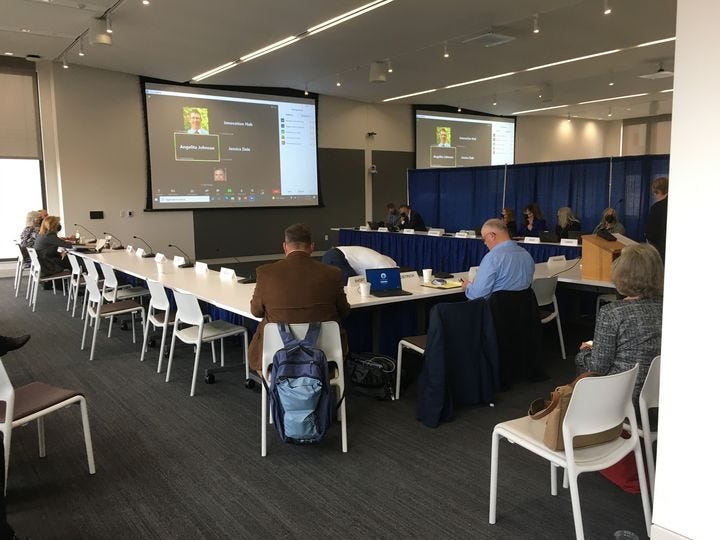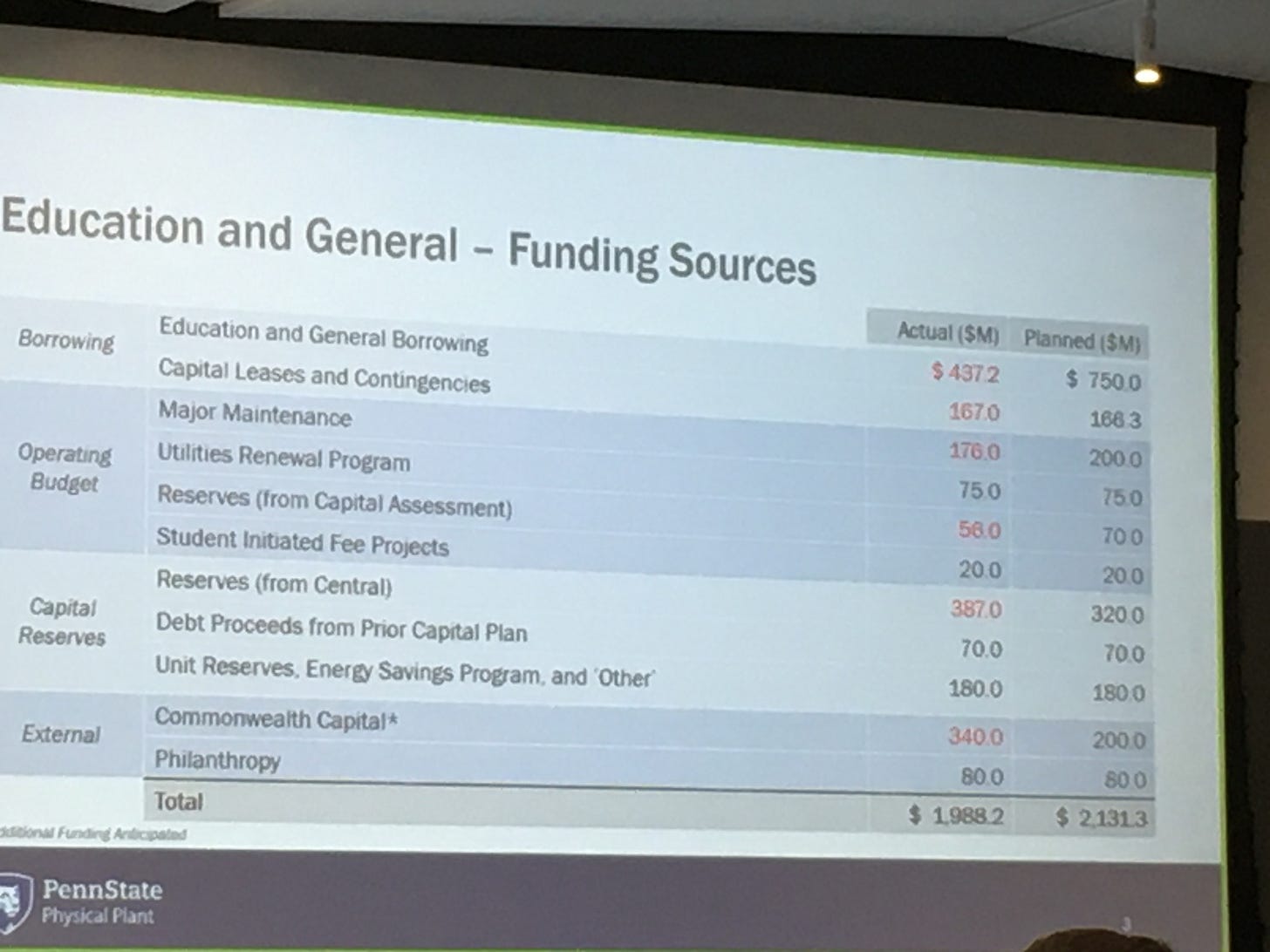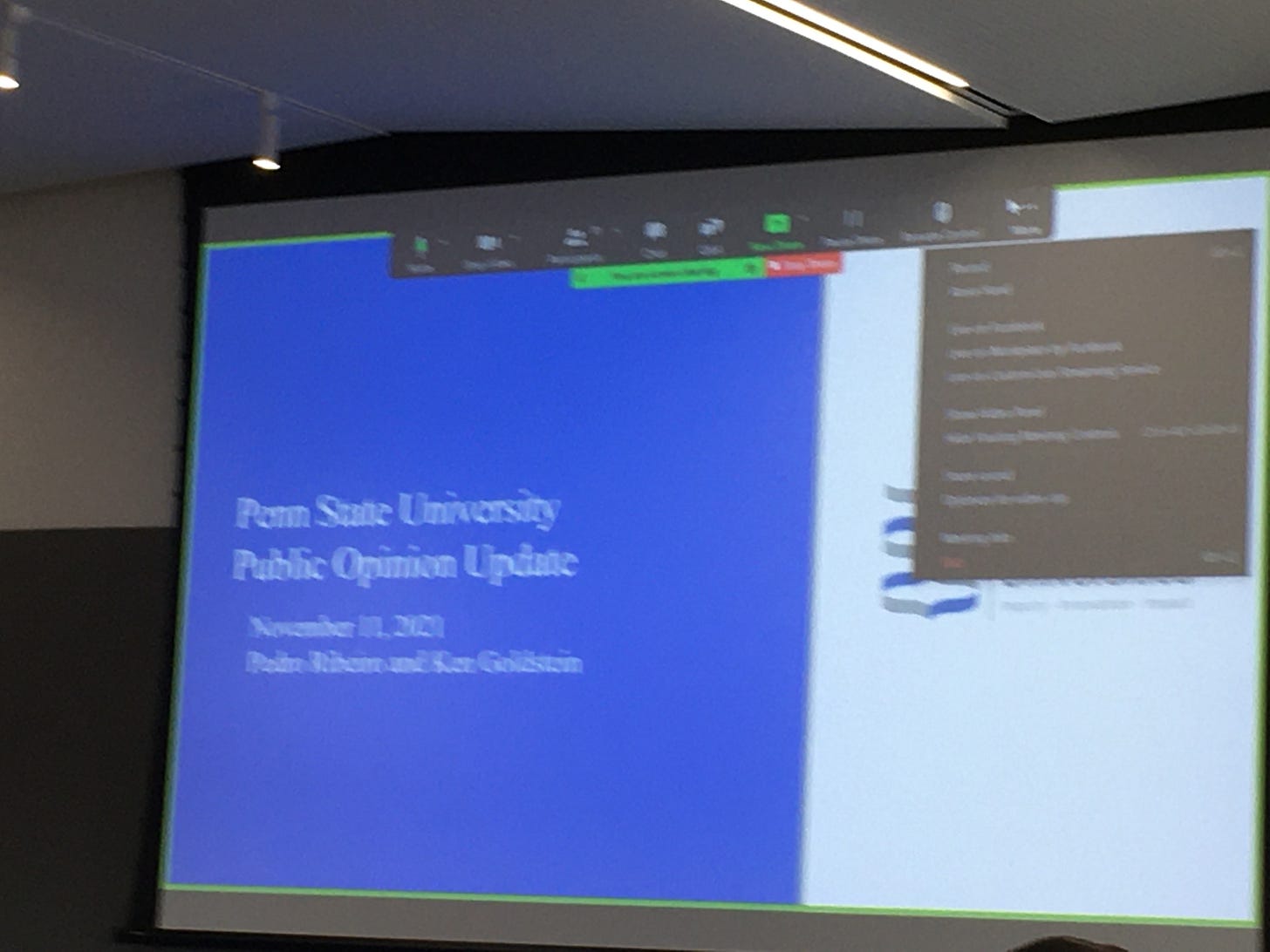There was not much in the way of Governance conducted at the November Board of Trustees meetings, but I will just highlight a couple of items, within a brief chronological summary of the non-governance goings-on that might be of interest.

HIGHLIGHTS:
A potential highlight was Sandy Barbour’s presence for the Compensation Committee meeting. Barbour is not normally present, so this might indicate an athletics-related contract discussion was taking place, behind closed doors. Rumor say James Franklin? Stay tuned.
During the Outreach Committee meeting I was able to get in a question/comment to the Board. This is unusual for a couple of reasons - most notably that the Committee Chair, Barbara Doran, typically does not allow comments from non-trustees - but I was “granted the floor” for a moment by the presenters from the AAU (Association of American Universities) presenters. You can see the details below, in the notes about the Outreach Committee.
Morning Meetings of BOT
FINANCE COMMITTEE:
There were no projects to approve today, so the meeting was an update on the current 2018-2023 Capital Spending Plan, limited to capital spending for "General & Educational" projects. This did not include non-educational projects, such as Athletics, and other auxiliary projects.
The total target for Capital Spending during the 5-year period is $4.7 billion.
The presentation focused on "How Far Behind Penn State is in Maintaining Their Infrastructure”, and was presented by Penn State Chief Facilities Officer Bill Sitzabee. Eric Barron made a comment that Penn State has fallen behind, intentionally and deliberately, in large part because he has prioritized maintaining low tuition versus spending on maintenance. Yes, he said that.
While not discussed during the meeting, there was some interesting information - that most people are not aware of - brought to mind by this slide.
Note the next to last line item on the slide, “Commonwealth Capital”. This is something that is never discussed, especially when Penn State Trustees lament over lack of State funding for the University.
In recent years, these requests for taxpayer dollars have averaged over $500 million per year, over and above the “General Appropriation”. (Note that this slide just lists the $340 million of Commonwealth Capital for General & Educational construction, not the total for all University projects). The funding Penn State receives from the Commonwealth, to pay for capital projects, is by far the largest such appropriation of taxpayer funds of any university in the Big Ten.
Further, it is a process that most Penn Staters are not aware of.
The state subsidy that we do often hear talked about is the General Appropriation, currently about $350 million per year, which comes in at right about average per student for Big Ten universities.
OUTREACH COMMITTEE was up next:
The discussion was two parts:
Item 1:
Larry Lokman, VP Communications, talking about Penn State's crisis communications plans. Nothing of interest there.
Item 2:
A presentation from a couple of folks from the AAU about the declining image and perception of Higher Education throughout the United States, including Penn State University.
The AAU presenters provided a report of how the public's perceptions of Higher Education have been dropping. The focus was on how the public increasingly views Higher Education (including, of course, Penn State) as no longer providing a worthwhile and affordable education. It focused on how Penn State, and other Universities, can try to alter public perceptions through their PR efforts.
At the end of the presentation, during the Q&A session, I was able to pose a question/comment to the presenters and the Penn State Trustees. The question/comment was this:
"Wouldn't it be more prudent and responsible for Penn State to devote their full efforts towards working on the issues that folks - students, parents, etc - have with Higher Education. Things like affordability and quality of education. Rather than to divert energy trying to "PR" those folks into believing those are not significant issues?".
The idea of actually focusing on "being better", as opposed to trying to convince people that they were wrong - and we were doing a wonderful and optimal job - was met with silence from the Trustees. Later, President Barron made a few "counter comments", wherein he said that declining perceptions were not an issue at Penn State. The idea - of striving to be better - seemed utterly foreign to them.
That was it for the morning. There were three more committee meetings scheduled after lunch.
First of the afternoon was LEGAL COMMITTEE:
As per usual, roll was taken, and then all "public" was kicked out, due to "privilege" (even though most of what the Committee addresses is not confidential information) .
C'est la Vie.
Next up was ACADEMIC AFFAIRS:
Today’s AA meeting is a discussion of Penn State advising. The format was to ZOOM in various Advising Administrators and a selection of students to discuss their relationships with “Penn State Advising”
No Governance issues discussed throughout meeting - solely a conversation, FWIW.
Alice Pope actually (kind of) brought up a “governance relevant” point with regard to advising. It was basically thrown away - partly because the allowed time for the meeting was essentially over, partly because no one seemed interested.
Last up was the COMPENSATION COMMITTEE:
Again, as per usual, it was taken in private - kicking out any "public" (Public, as per usual, being, basically, me - since there are so few, if any, other members of the public attending the meetings).
Note the item listed above, under “Highlights” with regard to Sandy Barbour’s presence.
And that was it.






Do you EVER have anything positive or constructive to say, other than sardonically? Has it ever occurred to you that your pessimism and disagreeable attitude (about seemingly everything) may be why you have never been successfully elected to the board of trustees?